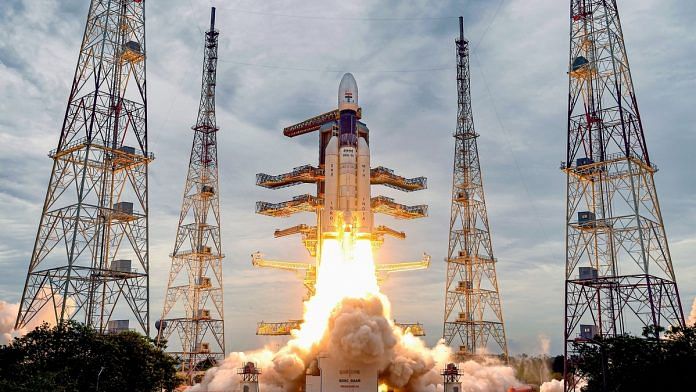Bengaluru: On 22 July, India’s biggest and most powerful rocket — GSLV Mk-III — inserted Chandrayaan-2 into an orbit of 170 km x 39,120 km. The spacecraft is currently in orbit around Earth.
Chandrayaan-2 was initially scheduled to be launched on 15 July, but was called off due to a technical snag in the launch vehicle system. The spacecraft consists of three vehicles: The Chandrayaan-2 orbiter, the Vikram lander (named after Vikram Sarabhai, the father of India’s space programme), and the Pragyan rover.
Described as ISRO’s most complex mission so far, Chandrayaan-2 is expected to land an orbiter on the moon and build on its predecessor’s startling discovery of water on the Earth’s satellite.
ThePrint takes a look at the stages that Chandrayaan-2 will go through in the next few weeks until its landing on the moon.
Earth-bound phase
Around Earth, as Chandrayaan-2 revolves, it will perform four orbit-raising manoeuvres. This number has been updated from the original plan of five orbit-raising manoeuvres. This means during its numerous orbits, the spacecraft will fire its motors on four separate occasions — swinging around and using its gravity each time to increase speed and altitude. Thus, each orbit is more elongated than the last.
Eventually, it will obtain enough velocity and altitude to escape Earth’s gravitational pull and be on its way to the moon.
This phase is expected to last 23 days and is likely to end on 13 August.
Lunar transfer trajectory phase
The next phase is all about simply coasting to the moon. This path, to be taken by the spacecraft, is called the lunar transfer trajectory. It commences with a procedure called trans-lunar injection — this is the time when Chandrayaan-2 will move from Earth’s neighbourhood to that of the moon’s.
This phase is expected to last eight days. Chandrayaan-2 will enter the moon’s influence of gravity on 20 August.
Also read: Chandrayaan-2 launch proves India is a major player in the race for space dominance
Lunar-bound phase
On the 30th day from the launch, Chandrayaan-2 will reorient itself to face away from the moon instead of towards the moon. Then, it will fire its retro thrusters, which act as a brake so that the speeding spacecraft can slow down and not simply zip past the moon.
Once Chandrayaan-2 slows down sufficiently, it will insert itself into an orbit. But this will not be the spacecraft’s final orbit — it will be an elliptical insertion orbit.
Chandrayaan-2 will then perform the opposite of what it did in the Earth-bound phase: As it revolves around the moon, on four separate orbits, it will lower itself, as opposed to raising its orbit. Finally, on the fifth orbit-lowering manoeuvre, it will enter into a circular orbit of 100 km from the lunar surface. This is the final orbit for the orbiter component of the spacecraft.
The orbital insertion process is expected to take a total of 13 days, and will come to an end on 1 September.
Landing phase
On 2 September, the 43rd day since launch, the Vikram lander will separate from the orbiter. It will then orbit the moon, slowing down from the speed at which it was orbiting with the orbiter. This will happen over the course of five days.
On 7 September, it will start its descent and perform a soft landing near the southern polar region.
As soon as it lands and is stable on the surface, it will promptly open a hatch, lower a ramp, and release the Pragyan rover.
Mission’s lifespan
The lander and rover will function for half a lunar day, i.e, 14 Earth-days, where there is continuous daylight. During this time, the vehicles’ circuits will constantly and slowly be fried by the sun’s intense solar radiation.
Then, when the 14 Earth-day long night sets in, the vehicles will begin to freeze as temperature drops. They are not expected to function again.
The orbiter will continue to stay in orbit and transmit data for a minimum of one year.
This report has been updated to explain earth-bound and lunar-bound phases more accurately.
Also read: Chandrayaan-2 lifts off, expected to land on Moon in September



